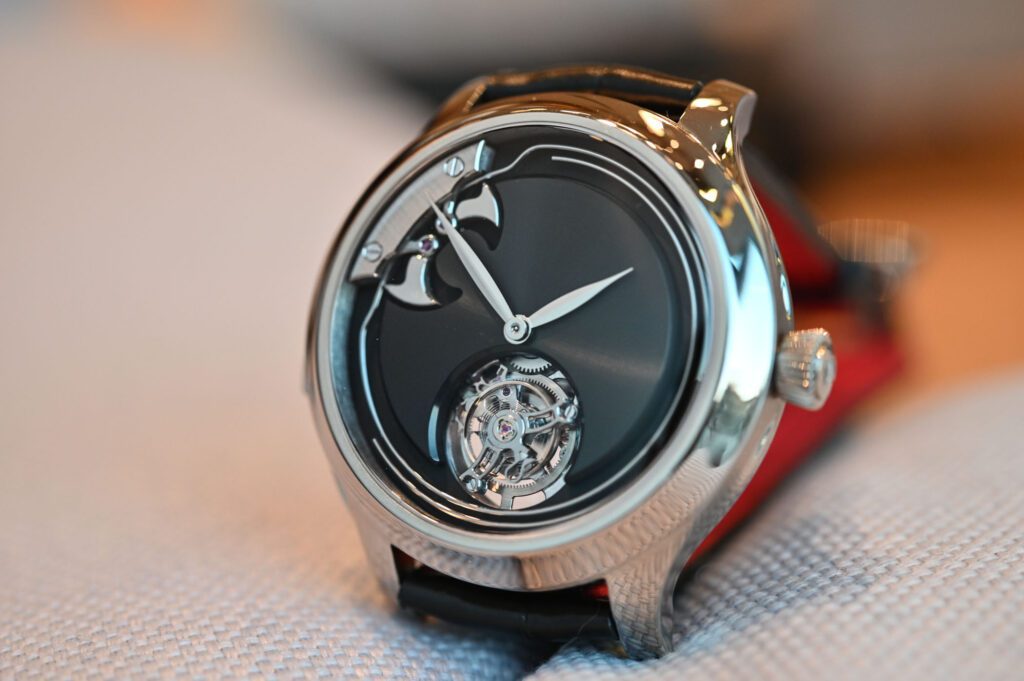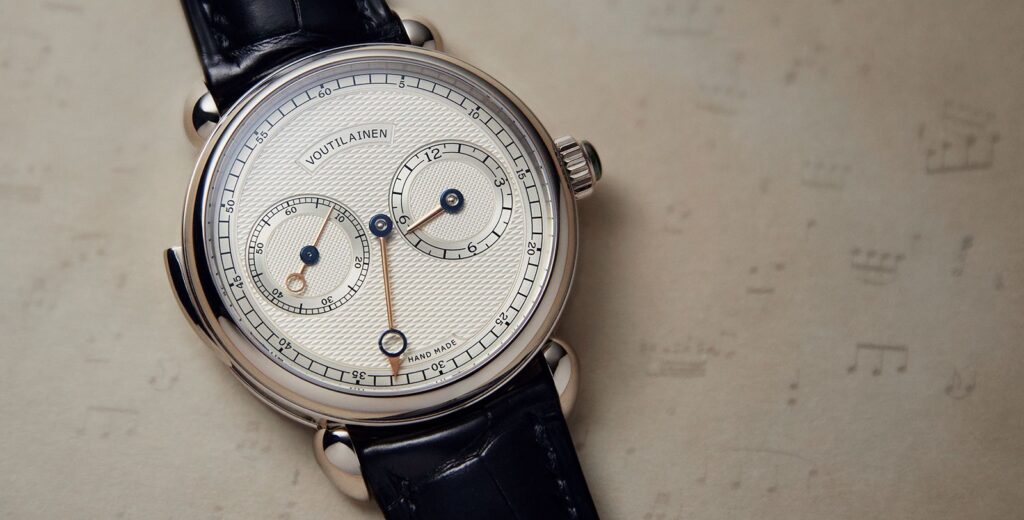8 Watch Chimes for Repeating Time
Okay, we decided to go the Buzzfeed list route in today’s TimesTicking post. With that in mind—lists can be pretty dang helpful when talking shop on watch terminology. So we’re going to break down eight (count ‘em “eight”) watch chimes that encompass hourly, quarterly, and down-to-the-minute repetition. That’s right, the world of mechanical watches has more than a few options when it comes to these repeating ‘complications’ (functions beyond time telling). Constructing them is like scaling down a clock repeater and takes a level of engineering prowess that often takes a lifetime to achieve. So, without further ado, here are 8 watch repeaters to keep an ear to the ground (or to the wrist) for.
1.) Minute Repeater

Before we begin on this traditionally popular chime, we’d like to say that the word “repeater” is going to be thrown around quite a bit—this is a horological term that essential means “chime” (with repeatable sounds). A Minute Repeater is activated via a lever on the case. As the name suggests, it gives a chime that gives the time down to the minute. Hours are provided by a deeper chime, quarter hours are noted by two tones (a smaller and larger hammer), and minutes round things out with the highest tone(s). If the time is, say, 4:39, you’d get 4 low hits, two double-hits, and nine higher tones. It takes a (figurative) minute but it’s a classic eyes-free way to tell the time.
2.) Quarter Repeater
Where the Minute Repeater goes down to the minute, the Quarter Repeater simply goes to the quarter hour. Striking similarly to the Minute Repeater, there’s a low tone to count the hours and double-strikes for the quarter hours. If it’s 3:45 you’d get a “dong dong dong” then a “ding-dong, ding-dong, ding-dong”. Yes, the onomatopoeias are necessary.
3.) Half-Quarter Repeater
These repeater chimes are a sort of in-between regarding the Quarter and Minute Repeater mechanisms. They go just beyond a Quarter Repeater by also chiming out any seven-and-a-half minute passage of time (half of a quarter hour). See the above Quarter Repeater for the first two chimes—then add a high ping to indicate if another half-a-quarter has passed. Quite a unique one that rarely gets the spotlight.
4.) Five Minute Repeater
Halfway there and we’re on the final Minute Repeater style chime! It made its first appearance in the early 18th century and keeps things pretty straight-forward. Five Minute Repeaters chime the hour, then follow with a higher chime that indicates how many times five minutes have passed from the hour. So, 1:55 would be “dong” then “ding x11”. Are you glad we didn’t type those all out? It’s not surprising that these ones didn’t remain too popular.
5.) Decimal Repeater

Heavily related to the Minute Repeater style watches, these chimes require a remote release from the wearer. Where slide levers releases exist now (for all repeaters mentioned in this list), there used to be a release on the crown. That got a bit troublesome, so through the 19th century virtually all repeater watches took on a slide-lever. Decimal Repeaters were no exception to this change and activate as such. Once activated, Decimal Repeaters sound off the hours, the tens-of-minutes, and then the minutes past each ten. Deca meaning “10”, thus “Deci-”, a wearer gets at 1:35 “dong”, then a “ding-dong, ding-dong, ding-dong” followed by a series of “ding, ding, ding, ding, ding”. Minute Repeater adjacent, undoubtedly.
6.) Grande Sonnerie
Yes, that’s French up there (Swiss watchmaking leaving its mark). Sonnerie essentially means “alarm” in French. This naming indicates that it’s a striking movement—sort of. Striking movements chime automatically. Grande Sonneries perform this function for the hour and quarter hour. However, they can also be activated like a Repeater to indicate the hour on-demand. The arrangement of the chimes also differ from Repeaters. If it’s 6:30 there’ll be two chimes to indicate two quarter-hours passing, then a lower six chimes to indicate the hour.
7.) Petite Sonnerie
As one can guess, where there’s a Grande Sonnerie a Petite Sonnerie just means “smaller alarm”. These little strikers function almost exactly as their Grande counterparts. The key difference is that they only indicate the hour at the top of every hour. Thus, the wearer only gets a petite chime on the quarter hours past the top of the dial.
8.) Dumb Repeater

The naming of this repeater is pretty insensitive in today’s parlance (think Deaf, Dumb, and Blind). Dumb Repeaters are designed for deaf and hard-of-hearing folks. They began emerging in the watch market around the late 18th century and have plenty of electronic counterparts to this day. Instead of making a sound, they strike blocks inside of the watch, indicating the hours and minutes via vibrations. Picking up good vibrations is easy with these repeaters, as long as you’re actually on time to where you’re headed.
A Bonus: Audocron
One of the first watches patented for the blind was the Audocron Repeater. Although regular repeaters could do the trick, this was the first attempt by a watchmaker to focus on blind clientele. 18,000 of them were released after their conception in 1930 and their existence paved the way toward talking electronic watches. Each one functioned similarly to a Decimal Repeater.
Final Thoughts
Recently a watch with multiple chime complications sold at auction for $31million—setting the record for the most expensive watch ever sold. The Patek Philippe Grandmaster Chime (as it’s known) contains a Petite Sonnerie, Grande Sonnerie, and a Minute Repeater in one wristwatch. Engineering this watch is the culmination of 175 years of watchmaking from Patek Philippe, combined with the inventive spirit of much older watchmakers.
Regarding chimes generally, we’d like to reiterate that these are pretty watch-centric complications. Unlike striking clocks that chime at regular intervals, these “repeater” style chimes are more on-demand from the wearer (excepting the Sonnerie hybrids). These mechanisms date back to the late 17th century and onward. Eventually making their way to watches from clocks—they require 100s of smaller parts to function (on mechanicals). Some of these repeating chimes are available in electronic watches, but it’s a mark of true craftsmanship when a watchmaker puts their foot to the grinder on piecing together these sonorous watches. Hopefully the list has been helpful in understanding how much masterful minutiae goes into designing even the simplest of chimes. And if you own a Repeater or Sonnerie movement watch, keep it in good repair. Without repeated maintenance, chiming watches can truly lose their song.
Times Ticking has been in operation for more than 30 years, since 1982. We have performed watch repair for customers both locally and internationally. If it Ticks! We KNOW it! Our team of watch repair technicians have a combined experience in watchmaking of over 120 years.

